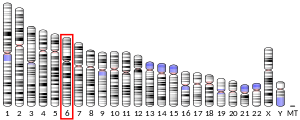MTCH1
Mitochondrial carrier homolog 1 (MTCH1), also referred to as presenilin 1-associated protein (PSAP), is a protein that in humans is encoded by the MTCH1 gene on chromosome 6.[5][6][7] MTCH1 is a proapoptotic mitochondrial protein potentially involved in Alzheimer’s disease (AD).[6][7][8]
Structure
The protein encoded by this gene is named for its structural resemblance to the members of the mitochondrial carrier protein family.[5][7] The MTCH1 gene contains 12 exons and produces four isoforms. These isoforms arise from alternative splicing of exon 8 and two potential start codons, which results in the deletion of 17 amino acid residues in the hydrophilic loop between two transmembrane domains of some isoforms.[9][10] Though they differ in sequence and length, the four isoforms still share a similar topological structure, including six transmembrane domains, one of which is responsible for localization to the outer mitochondrial membrane (OMM), and two N-terminal apoptotic domains. As a result, all four isoforms retain these apoptotic domains and mitochondrial localization, both of which are required for the protein’s proapoptotic function.[7][9][10]
Function
MTCH1 is a proapoptotic protein that localizes to the OMM and induces apoptosis independently of BAX and BAK.[6][7] One possible mechanism proposes that its interactions with the mitochondrial permeability transition pore (MPTP) complex leads to depolarization of the mitochondrial membrane, release of cytochrome C, and activation of caspase-3.[5][7] Expression of this protein is observed in 16 different tissue types, indicating that the protein may serve a housekeeping function.[10]
Clinical Significance
MTCH1 may be associated with AD and other neurodegenerative and neuroinflammatory diseases through its close interaction with presenilin.[5][8] However, more research is required to confirm its clinical involvement.[8]
References
- GRCh38: Ensembl release 89: ENSG00000137409 - Ensembl, May 2017
- GRCm38: Ensembl release 89: ENSMUSG00000024012 - Ensembl, May 2017
- "Human PubMed Reference:". National Center for Biotechnology Information, U.S. National Library of Medicine.
- "Mouse PubMed Reference:". National Center for Biotechnology Information, U.S. National Library of Medicine.
- Xu X, Shi YC, Gao W, Mao G, Zhao G, Agrawal S, Chisolm GM, Sui D, Cui MZ (Dec 2002). "The novel presenilin-1-associated protein is a proapoptotic mitochondrial protein". J Biol Chem. 277 (50): 48913–48922. doi:10.1074/jbc.M209613200. PMID 12377771.
- "Entrez Gene: MTCH1 mitochondrial carrier homolog 1 (C. elegans)".
- Lamarca, V; Marzo, I; Sanz-Clemente, A; Carrodeguas, JA (May 2008). "Exposure of any of two proapoptotic domains of presenilin 1-associated protein/mitochondrial carrier homolog 1 on the surface of mitochondria is sufficient for induction of apoptosis in a Bax/Bak-independent manner". European Journal of Cell Biology. 87 (5): 325–34. doi:10.1016/j.ejcb.2008.02.004. PMID 18375015.
- Vural, B; Sehitoğlu, E; Cavuş, F; Yalçınkaya, N; Haytural, H; Küçükerden, M; Ulusoy, C; Uğurel, E; Turan, S; Bulut, L; Türkoğlu, R; Shugaiv, E; Kürtüncü, M; Atakan, S; Güre, AO; Gül, A; Eraksoy, M; Akman-Demir, G; Tüzün, E (15 October 2013). "Mitochondrial carrier homolog 1 (Mtch1) antibodies in neuro-Behçet's disease". Journal of Neuroimmunology. 263 (1–2): 139–44. doi:10.1016/j.jneuroim.2013.08.007. hdl:11693/12552. PMID 24035008.
- Mao, G; Tan, J; Gao, W; Shi, Y; Cui, MZ; Xu, X (April 2008). "Both the N-terminal fragment and the protein-protein interaction domain (PDZ domain) are required for the pro-apoptotic activity of presenilin-associated protein PSAP". Biochimica et Biophysica Acta (BBA) - General Subjects. 1780 (4): 696–708. doi:10.1016/j.bbagen.2008.01.013. PMC 3509497. PMID 18291114.
- Lamarca, V; Sanz-Clemente, A; Pérez-Pé, R; Martínez-Lorenzo, MJ; Halaihel, N; Muniesa, P; Carrodeguas, JA (October 2007). "Two isoforms of PSAP/MTCH1 share two proapoptotic domains and multiple internal signals for import into the mitochondrial outer membrane". American Journal of Physiology. Cell Physiology. 293 (4): C1347–61. doi:10.1152/ajpcell.00431.2006. PMID 17670888.
Further reading
- Maruyama K, Sugano S (1994). "Oligo-capping: a simple method to replace the cap structure of eukaryotic mRNAs with oligoribonucleotides". Gene. 138 (1–2): 171–174. doi:10.1016/0378-1119(94)90802-8. PMID 8125298.
- Suzuki Y, Yoshitomo-Nakagawa K, Maruyama K, et al. (1997). "Construction and characterization of a full length-enriched and a 5'-end-enriched cDNA library". Gene. 200 (1–2): 149–156. doi:10.1016/S0378-1119(97)00411-3. PMID 9373149.
- Xu X, Shi Y, Wu X, et al. (2000). "Identification of a novel PSD-95/Dlg/ZO-1 (PDZ)-like protein interacting with the C terminus of presenilin-1". J. Biol. Chem. 274 (46): 32543–32546. doi:10.1074/jbc.274.46.32543. PMID 10551805.
- Lai CH, Chou CY, Ch'ang LY, et al. (2000). "Identification of novel human genes evolutionarily conserved in Caenorhabditis elegans by comparative proteomics". Genome Res. 10 (5): 703–713. doi:10.1101/gr.10.5.703. PMC 310876. PMID 10810093.
- Strausberg RL, Feingold EA, Grouse LH, et al. (2003). "Generation and initial analysis of more than 15,000 full-length human and mouse cDNA sequences". Proc. Natl. Acad. Sci. U.S.A. 99 (26): 16899–16903. doi:10.1073/pnas.242603899. PMC 139241. PMID 12477932.
- Clark HF, Gurney AL, Abaya E, et al. (2003). "The secreted protein discovery initiative (SPDI), a large-scale effort to identify novel human secreted and transmembrane proteins: a bioinformatics assessment". Genome Res. 13 (10): 2265–2270. doi:10.1101/gr.1293003. PMC 403697. PMID 12975309.
- Mungall AJ, Palmer SA, Sims SK, et al. (2003). "The DNA sequence and analysis of human chromosome 6". Nature. 425 (6960): 805–811. doi:10.1038/nature02055. PMID 14574404.
- Ota T, Suzuki Y, Nishikawa T, et al. (2004). "Complete sequencing and characterization of 21,243 full-length human cDNAs". Nat. Genet. 36 (1): 40–45. doi:10.1038/ng1285. PMID 14702039.
- Gerhard DS, Wagner L, Feingold EA, et al. (2004). "The status, quality, and expansion of the NIH full-length cDNA project: the Mammalian Gene Collection (MGC)". Genome Res. 14 (10B): 2121–2127. doi:10.1101/gr.2596504. PMC 528928. PMID 15489334.
- Lamarca V, Sanz-Clemente A, Pérez-Pé R, et al. (2007). "Two isoforms of PSAP/MTCH1 share two proapoptotic domains and multiple internal signals for import into the mitochondrial outer membrane". Am. J. Physiol., Cell Physiol. 293 (4): C1347–C1361. doi:10.1152/ajpcell.00431.2006. PMID 17670888.




